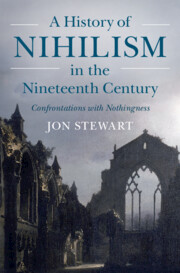Book contents
- A History of Nihilism in the Nineteenth Century
- A History of Nihilism in the Nineteenth Century
- Copyright page
- Dedication
- Contents
- Figures
- Preface
- Acknowledgments
- Introduction
- 1 Jean Paul’s Vision of Nihilism and Plea for the Doctrine of Immortality
- 2 Klingemann and the Absurdity of Nothingness in The Nightwatches
- 3 Nihilism in English Romanticism
- 4 Schopenhauer’s Theory of Human Suffering and Lack of Meaning
- 5 Büchner’s Account of the Reign of Terror as a Mirror of Human Existence
- 6 Poul Martin Møller’s Criticism of Hegelianism and the Danish Discussion of Nihilism
- 7 Kierkegaard and the Indefinability and Inexplicability of Death
- 8 Turgenev’s Portrait of a Nihilist
- 9 Nietzsche’s Vision of the Past and the Future of Nihilism
- 10 The Importance of Nihilism in the Nineteenth Century
- Selected Bibliography on Nihilism
- Name Index
- Subject Index
8 - Turgenev’s Portrait of a Nihilist
Published online by Cambridge University Press: 10 March 2023
- A History of Nihilism in the Nineteenth Century
- A History of Nihilism in the Nineteenth Century
- Copyright page
- Dedication
- Contents
- Figures
- Preface
- Acknowledgments
- Introduction
- 1 Jean Paul’s Vision of Nihilism and Plea for the Doctrine of Immortality
- 2 Klingemann and the Absurdity of Nothingness in The Nightwatches
- 3 Nihilism in English Romanticism
- 4 Schopenhauer’s Theory of Human Suffering and Lack of Meaning
- 5 Büchner’s Account of the Reign of Terror as a Mirror of Human Existence
- 6 Poul Martin Møller’s Criticism of Hegelianism and the Danish Discussion of Nihilism
- 7 Kierkegaard and the Indefinability and Inexplicability of Death
- 8 Turgenev’s Portrait of a Nihilist
- 9 Nietzsche’s Vision of the Past and the Future of Nihilism
- 10 The Importance of Nihilism in the Nineteenth Century
- Selected Bibliography on Nihilism
- Name Index
- Subject Index
Summary
Chapter 8 treats Ivan Turgenev’s influential portrait of a nihilist in his character Bazarov from the novel Fathers and Sons. Turgenev portrays the rise of nihilism as a conflict between the older and the younger generation in Russia that took place after the emancipation of the serfs in 1861. With his character sketch of Bazarov, Turgenev made the Russian nihilist movement famous throughout Europe. The story tells of the homecoming of the young Arkady Kirsanov who brings with him his friend from the university, Bazarov. The novel depicts the conflicts that arise when the two young men stay at the rural estate of Arkady’s father. Bazarov claims that nihilism is about negation, and his goal is to destroy everything and start again. When asked what his positive program is for afterwards, he surprisingly says that he does not have one. While Turgenev generally gives a sympathetic sketch of Bazarov, he cannot subscribe to his ideas. Like Jean Paul and Møller, he believes it is impossible to accept the idea that death is annihilation. His model is rather Bazarov’s simple grieving parents, who believe in something higher than death.
Keywords
- Type
- Chapter
- Information
- A History of Nihilism in the Nineteenth CenturyConfrontations with Nothingness, pp. 237 - 258Publisher: Cambridge University PressPrint publication year: 2023



